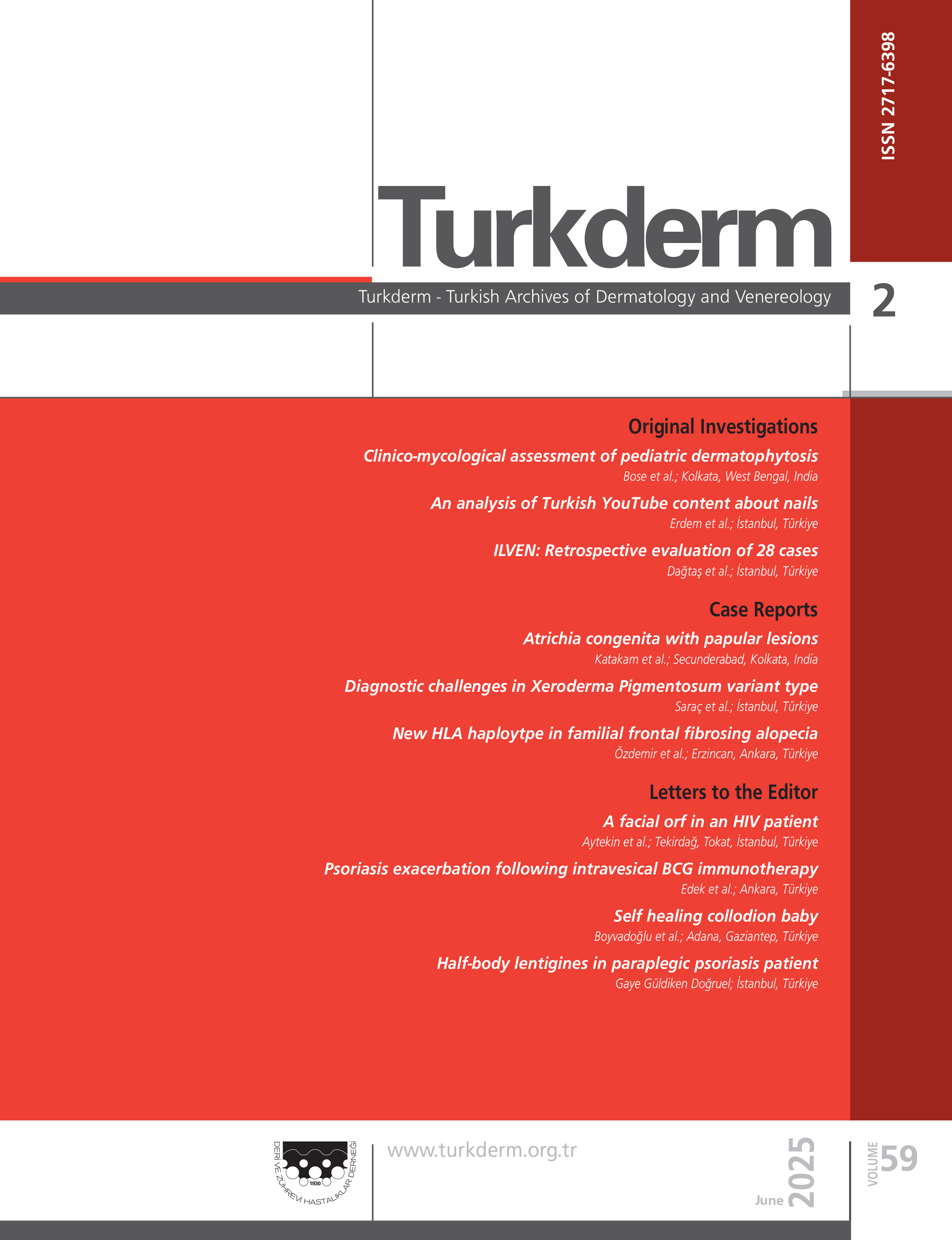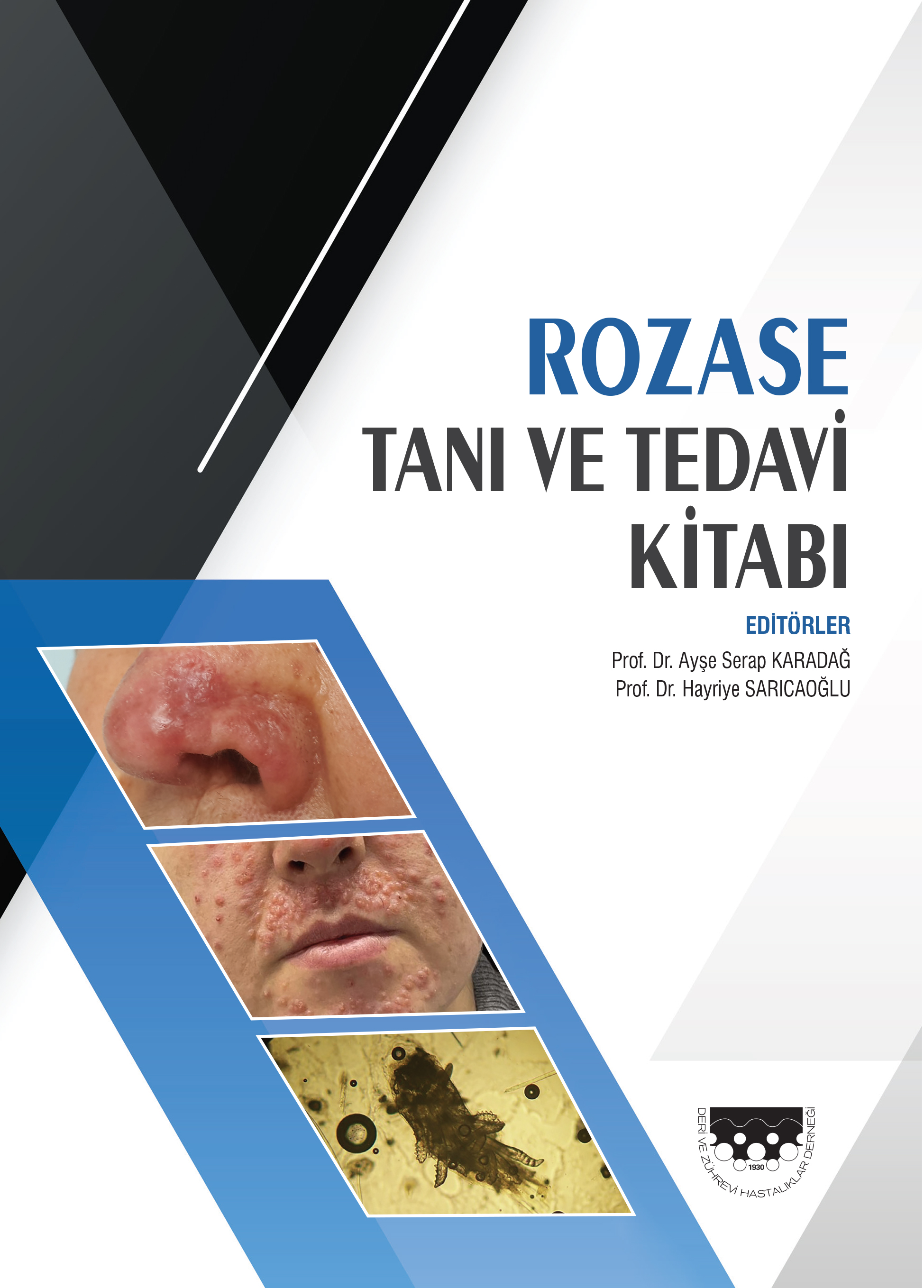Volume: 58 Issue: 1 - 2024
| 1. | Cover Pages I - IV |
| 2. | Editorial Ekin Şavk Page V |
| 3. | Editorial Fatih Göktay Page VI |
| ORIGINAL INVESTIGATION | |
| 4. | A study of biochemical factors and knowledge, attitude, and practice in patients with premature graying of hair Kanchan Dhaka, Sundeep Chowdhry, Sarika Arora, Paschal Dsouza, Ipshita Bhattacharya doi: 10.4274/turkderm.galenos.2024.75299 Pages 1 - 8 Background and Design: Premature graying of hair (PGH) is a clinical entity with multiple ramifications such as low self- esteem, inferiority complex and may interfere with an individuals social interaction capabilities and adversely affect the individuals psychosocial health. This study aimed to investigate the biochemical factors and knowledge, attitude, and practice in patients with PGH. Materials and Methods: A case control study including 75 cases and equal number of age and sex matched controls was conducted in a tertiary care hospital. Various epidemiological variables and biochemical parameters (vitamin B12, vitamin D, calcium, iron profile, lipid profile, thyroid hormones) were ascertained and compared between the cases and controls. The severity of graying was assessed using the Graying Severity Score, and a knowledge, attitude, and practice study was conducted by administering a pre-validated questionnaire to assess the impact on the quality of life of these affected individuals. Results: Significant differences between cases and controls in the serum levels of biochemical parameters, namely Vitamin B12 (p=0.001), vitamin D (p=0.004), serum iron (p<0.001), ferritin (p<0.001) and total iron binding capacity, i.e TIBC (p=0.037) and thyroid hormones T4 (p=0.002) and thyroid stimulating hormone (p=0.041) was found. No correlation between PGH and serum calcium and lipid profile was derived. Also, a statistically significant difference was noted in the appetite pattern of cases and controls (p=0.003). Stress, smoking, altered sleep pattern and bowel habits were also more prevalent in cases as compared to controls. It was also noted that most study cases belonged to the lower middle class of the modified Kuppuswamy scale. The Knowledge, Attitudes, and Practices (KAP) study, which was extremely comprehensive and detailed in nature, showed that PGH significantly affects these patients quality of life. Conclusion: The study reveals a strong association between PGH and deficiency of vitamin D, abnormal levels of vitamin B12, hypothyroidism and deranged iron profile, and altered appetite patterns. Along with this, the prevalence of stress, smoking, altered sleep patterns and bowel habits was also higher in PGH cases. Hence, all these parameters should be analysed in such patients. KAP analysis was a unique approach to studying common conceptions and practices in PGH cases and its psychological impact. |
| 5. | Effects of systemic isotretinoin treatment on hemogram, biochemical parameters, and inflammatory markers Işıl Deniz Oğuz, Sevgi Kulaklı doi: 10.4274/turkderm.galenos.2024.44442 Pages 9 - 14 Background and Design: Isotretinoin, a vitamin A derivative, is widely used to treat moderate and severe acne. Although the effect of systemic isotretinoin treatment on hemogram parameters has been demonstrated, the results are still controversial. In the present study, we investigated the effect of isotretinoin on biochemical parameters, hemogram, and inflammatory markers in the Black Sea Region. Materials and Methods: Medical data of 300 patients with moderate and severe acne vulgaris who received systemic isotretinoin treatment for at least three months were analyzed retrospectively. Hemogram parameters, serum creatinine levels, liver transaminase levels, serum lipid levels, neutrophil-to-lymphocyte ratio (NLR), platelet-to-lymphocyte ratio, and monocyte/high-density lipoprotein (HDL) ratios were evaluated before and three months after the treatment. Results: A significant decrease was found in leukocyte count, red blood cell count, neutrophil count, monocyte count, HDL levels, and NLR after three months of treatment compared to the baseline. A significant increase was found in platelet count, plateletcrit (PCT), platelet distribution width (PDW), red cell distribution width, hematocrit, mean erythrocyte hemoglobin, total cholesterol, low-density lipoprotein, triglyceride, and aspartate aminotransferase levels. Conclusion: According to our results, isotretinoin can affect several hemogram and biochemical parameters. In addition, this article is the only article demonstrating a decrease in monocyte count and an increase in PDW and PCT levels after the treatment of isotretinoin in the literature. |
| 6. | A comparative study of tangential or vertical application of spray cryotherapy in warts treatment Seda Yıldız Yeşildağ, Tuğrul Dereli doi: 10.4274/turkderm.galenos.2024.65392 Pages 15 - 20 Background and Design: Cryotherapy is an easy-to-apply and effective method in the treatment of warts. Numerous studies have been conducted on the effectiveness of cryotherapy in treating warts. However, in the literature, there is no comparative study on the treatment success, side effects, and superiority of vertical or tangential application to each other in spray cryotherapy. This study aims to compare both methods and to determine the ideal method for increasing patient compliance and treatment success in cryotherapy. Materials and Methods: Between December 2014 and March 2016, 25 volunteer patients with 173 warts on both hands were applied spray cryotherapy with the vertical method in one hand and tangential method in the other. The patients were evaluated in terms of both treatment success and side effects at three-week intervals. Results: The two methods did not differ in therapeutic efficacy (p>0.05). There was no difference between the two methods in terms of bullae (p=0.515) and hypopigmentation (p=0.709) formation. When the pain scores of two spray methods warts were compared according to warts diameters, the tangential applications pain score was lower in warts smaller than 2.5 mm (p=0.031). There was no significant difference in warts of other diameters (between 2.6-5.0 mm and greater than 5.0 mm) (p>0.05). Warts requiring three sessions of treatment (20/173) were compared in each session for pain scores. Regardless of the method, a significant decrease in pain score was found in each consecutive session (p<0.05). Conclusion: This is the first study to compare spray cryotherapys vertical or tangential application to the lesion. Based on the data of this study, tangential spray application is more comfortable than vertical application. Cryotherapy may be a more widely used method if tangential spray freezing becomes common. |
| CASE REPORT | |
| 7. | A case of lymphangioma circumscriptum successfully treated with topical sirolimus Malik Güngör, Aslı Bilgiç doi: 10.4274/turkderm.galenos.2023.06791 Pages 21 - 23 Children who have lymphatic malformations frequently experience functional limitations and aesthetic abnormalities that have a significant impact on their quality of life and may pose a threat to their lives. Conventional treatments such as surgery or sclerotherapy are rarely curative, demonstrating the great need for new treatment modalities. Recently, oral or topical administration of sirolimus has successfully treated lymphatic malformations. We report the 6-month treatment outcome of a 7-year-old boy with lesions consistent with lymphangioma circumscriptum on the left side of the neck since birth who was successfully treated with topical sirolimus. |
| 8. | Unusual histopathological findings of lupus miliaris disseminatus faciei: A case report Pooja Bains, Priya Kapoor, Navleen Kaur doi: 10.4274/turkderm.galenos.2024.55531 Pages 24 - 26 Lupus miliaris disseminatus faciei (LMDF) is a chronic granulomatous disorder affecting the face in young adults with sudden eruption of asymptomatic skin colored to red-brown papules on cheeks, eyelids and few extrafacial sites including ears and neck. There has been disputation about the origin of the disease, but the consensus is that it is an immune response to the pilosebaceous unit. Various histopathological studies have found granulomas in association with pilosebaceous units. The present case discusses the rare occurrence of foreign body granuloma surrounding a ruptured infundibular cyst in the case of LMDF. The role of a ruptured infundibular cyst in the induction of an inflammatory reaction resulting in the development of granuloma in LMDF cannot be ruled out. |
| WHAT IS YOUR DIAGNOSIS? | |
| 9. | What is your diagnosis? Selma Sönmez Ergün, Ahmet Kirazoğlu doi: 10.4274/turkderm.galenos.2023.37729 Pages 27 - 28 A 72-year-old male patient was admitted to our clinic with a slowly growing mass on the right ala nasi that has been present for 2 years. His medical history was not remarkable. On examination, an immobile mass of rubber consistency 2.5x2.5 cm in size with polypoid appearance was found on the right ala nasi that expanded the right nasal wing and infiltrated the surrounding cheek tissue. Lymphadenopathy was not detected on the neck examination. A punch biopsy was performed. Histopathological examination revealed that it was a mesenchymal neoplasm with myxoid features. Histopathological examination after total excision revealed a nodular formation containing spindle cells and mast cells within myxoid edematous stroma in the dermis. Although the right nostril was narrower than the opposite side, an aesthetically acceptable appearance was obtained. The patient, who was followed up with dressings, recovered uneventfully. There was no recurrence at 18-months follow-up. |
| OTHER | |
| 10. | Erratum doi: 10.4274/turkderm.galenos.2024.e001 Page 29 Abstract | |























